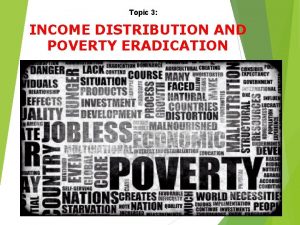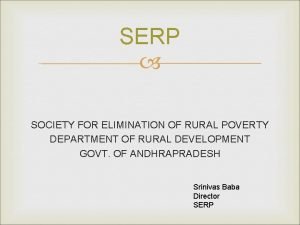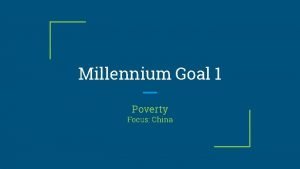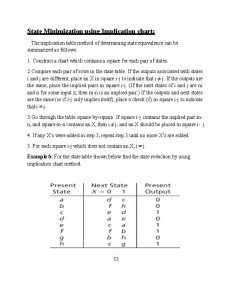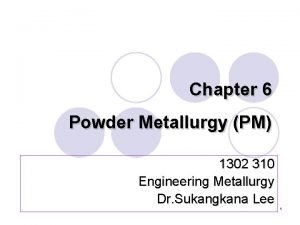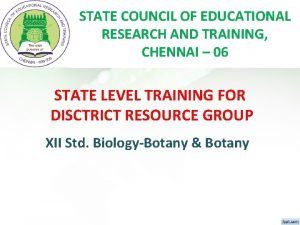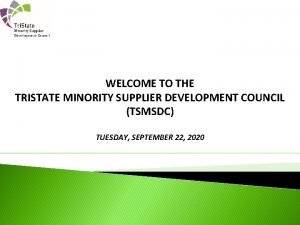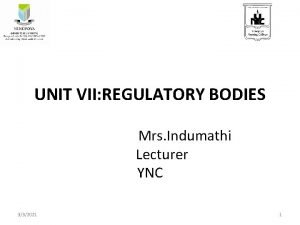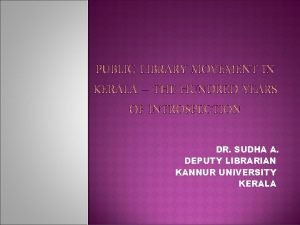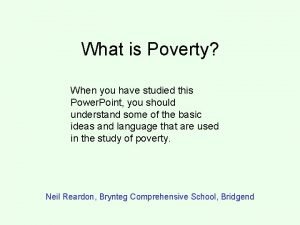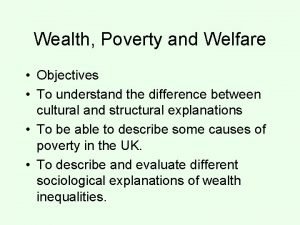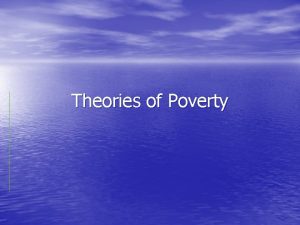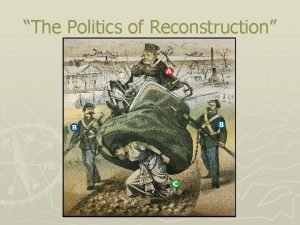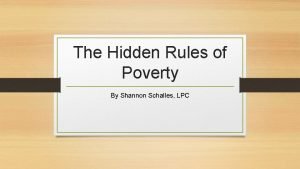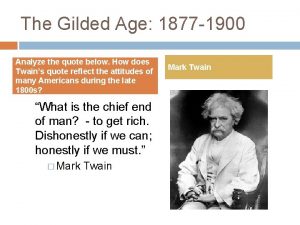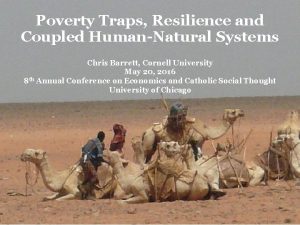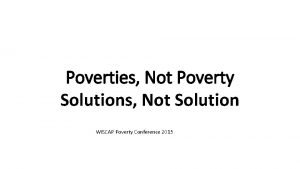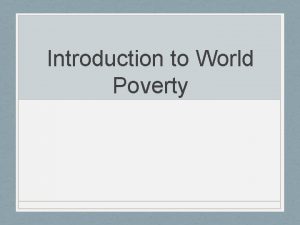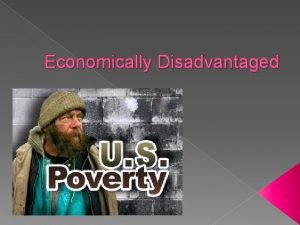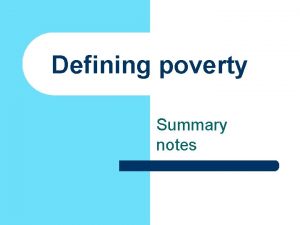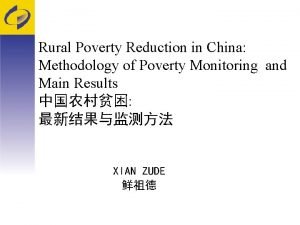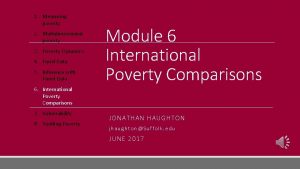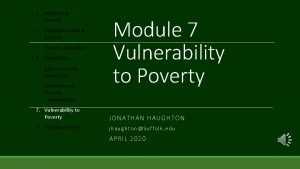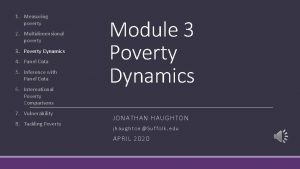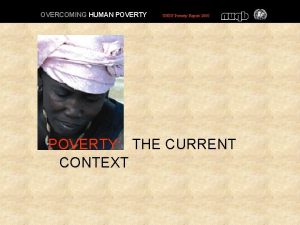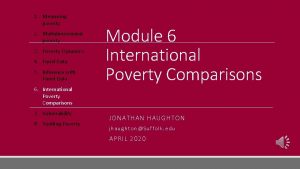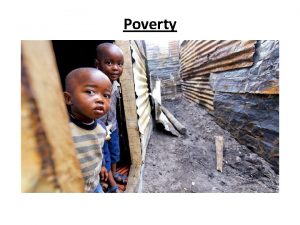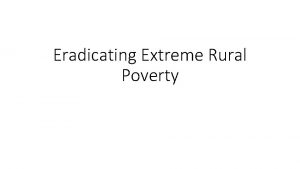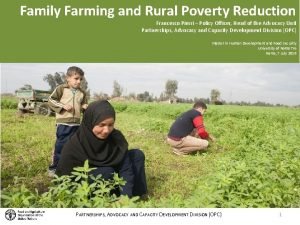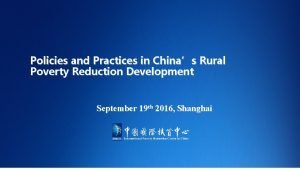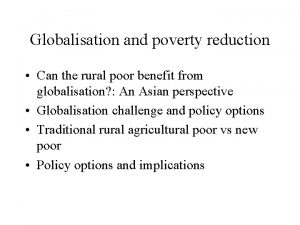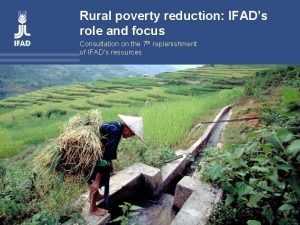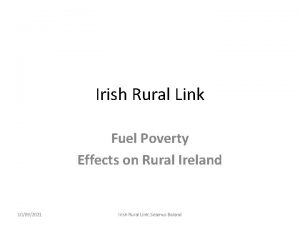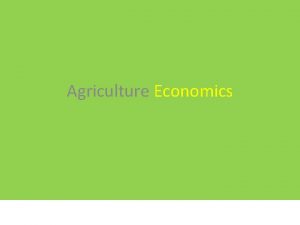Rural Poverty Reduction in China The State Council










































































- Slides: 74

Rural Poverty Reduction in China The State Council Leading Group Office of Poverty Alleviation and Development, China 2010. 09. 16 1

outline 1 China’s success against poverty 2 Factors behind China’s success poverty reduction story 3 Methods for “development oriented poverty reduction” 4 Challenges faced by China’s poverty reduction 5 Thought for the next step 2

1 China’s Success Against Poverty Through the 31 years after the reform, poverty reduction in China achieved world renowned success (1)Poor population substantially reduced (2)Rural household income increased (3)Infrastructure dramatically improved (4)Social development boosted (5)Regional economic development accelerated 3

1 China’s Success Against Poverty (1) Poor Population substantially reduced Rural absolute poor population has been reduced from 250 million in 1978, to 14. 79 million in 2007, its share in rural population reduced from 30. 7% to 1. 6% Rural lower income population reduced from 62. 13 million in 2000 to 28. 41 million, its share in rural population reduced from 6. 7% to 3% 4

1 China’s Success Against Poverty Dropping number of absolute poor and poverty incidence Number of absolute poor (10, 000 persons) Absolute poverty rate(%) 5

1 China’s Success Against Poverty incidence of China: proportion of poor population under different poverty lines 90 80 70 $ 1. 25 International poverty line 60 50 40 30 $ 1. 08 poverty line 20 10 0 Poverty line set by the Chinese government 1981 1984 1987 1990 1993 1996 1999 2001 2005 2007 6

1 China’s Success Against Poverty (2)Rural household income increased From 1989 to 2008, per-capita net income for rural household in the nationally focused poverty counties increased from 303 Yuan to 2611 Yuan From 2003 to 2007, net income for rural household in the nationally focused poverty counties increased from 1305 Yuan to 2278 Yuan, with five-year average annual growth of 9. 04%, continuously higher than the national average growth of 7. 47% in five consecutive years 7

1 China’s Success Against Poverty Net income growth rate for rural households in the nationally focused poverty counties continuously higher than the national average in last five years (%) 8

1 China’s Success Against Poverty (3)Rural infrastructure dramatically improved Changes in the poor natural villages in nationally focused poor counties from 2002 to 2008 Road access 72. 21% → 84. 4% Electricity 92. 79% → 96. 8% Telephone 52. 39% → 87. 5% Television and radio 83. 68% → 92. 9% 9

1 China’s Success Against Poverty Rural infrastructure dramatically improved 10

1 China’s Success Against Poverty (4)Social development continues to grow Implementation of the nine-year compulsory education Participation ratio of new rural cooperative medical system reaches 91. 5% Minimum living allowance system in rural areas 11

1 China’s Success Against Poverty From 2002 to 2008 Villages with kinder garden and pre-school education increased from 7. 38% to 55. 2% Villages with rural medical facilities increased from 9. 86% to 77. 4% Villages with qualified rural doctors and sanitary staff increased from 10. 18% to 77. 4% Villages with qualified midwife increased from 9. 58% to 73. 7% 12

1 China’s Success Against Poverty 13

1 China’s Success Against Poverty (5)Regional economic development accelerated From 2000 to 2008, the per-capita GDP of 592 nationally focused poor counties increased from 2500 Yuan to 8368 Yuan, with an annual increase of 22. 2%; the per-capita local fiscal budgetary revenue increased from 116. 5 Yuan to 354. 3 Yuan, with an annual increase of 24. 5% Some resource giants, tourism giants and counties with successful industrial structure adjustment realized extraordinary development. The per-capita GDP of 37 counties and per-capita fiscal revenue of 61 counties exceeded the average of total 2072 counties 14

1 China’s Success Against Poverty Numbers of Poor by Region 1981 -2005 (WWW. WORLDBANK. ORG. CN) 15

1 China’s Success Against Poverty Proportion of people living under $1 per day 16

1 China’s Success Against Poverty Contribution to the world poverty reduction Based on the Chinese poverty line, rural absolute poor has been reduced from 85 million (9. 6% of rural population) in 1990 to 14. 79 million (1. 6% of rural population) in 2007. China is the first developing country reaching the poverty reduction target of MDGs. Even if applying the international poverty line of $ 1 person per day adopted by MDG, the proportion of rural poor has been reduced from 46% in 1990 to 10. 4% in 2005. This also testifies the realization of China for accomplishing poverty reduction task within the MDG context From 1990 to 2005,the world population living under the $1 /per day has been reduced to 1. 4 billion with a reduction of 418 million (23% reduction). The world poor population has increased by 58 million if China is excluded. (“China’s Progress Towards the MDGs” jointly drafted by the Ministry of Foreign Affairs, China and UNDP) 17

1 China’s Success Against Poverty World Bank Assessment Report(March, 2009) In the first half of the 11 th Five-Year Plan, poverty continued to drop dramatically. It is estimated that the proportion of the population living under the World Bank poverty line in China reduced from 10. 3% in 2004 to 4. 0% in 2007 (the figure for rural areas was 5. 4%) 18

2 Factors behind China’s Success Poverty Reduction Story (1)Reform and opening-up policy, institutional innovation (2)Economic growth, strengthened economic basis (3)Integrated urban and rural development, policy of feeding back to agriculture (4)Development oriented poverty reduction and self reliance 19

2 Factors behind China’s Success Poverty Reduction Story (1)Reform and opening up policy, institutional innovation Poverty is not socialism! In December 1978, the 3 rd Plenary Meeting of the 11 th Central Committee of CCP, confirmed the strategic decision to shift to economic development 20

2 Factors behind China’s Success Poverty Reduction Story (group photo of people who took the lead in “Dabaogan”-all-round responsibility system) 1978: Institutional reform driven poverty reductionintroduce reform and opening up policy, scrap people’s commune, establish household responsibility system 1986: Specific plans driven poverty reduction identify development based poverty reduction principle, “turning blood transfusion to blood creation”, build the poor’s self development capacities. 2002: Integrated urban rural poverty reduction strategy economic development, rural urban development is coordinated, a grand poverty reduction structure 21 has taken shape.

2 Factors behind China’s Success Poverty Reduction Story 2007: “two-wheel ” mode for poverty reduction set up minimum living allowance system Adjust poverty line Implement two wheel mode for poverty reduction 22

2 Factors behind China’s Success Poverty Reduction Story (2)Economic growth and infrastructure development An average annual growth of 9. 8% from 1978 to 2007 Fiscal revenue exceeded 6 trillion Yuan, and the per-capital GDP reached $2770 Provide numerous employment opportunities (including developing township enterprise, over 200 million rural labors took off-farm work Agricultural infrastructure strengthened with outputs increased remarkably, feed 22% of world population with 9% land 6% water resources, meet basic needs for food Create conditions for structural adjustment (including returning the farmland to forest and ecological construction) 23

2 Factors behind China’s Success Poverty Reduction Story Relations between Economic Growth and Poverty Reduction Economic growth is critical to the success of China’s poverty reduction. During 1981 to 2005, the poverty rate reduced by 9% for every 10% per-capita GDP increase 24

2 Factors behind China’s Success Poverty Reduction Story 25

2 Factors behind China’s Success Poverty Reduction Story (3)Integrate urban-rural development and implement the policy of feeding back to agriculture Four kinds of subsidies, four kinds of reductions or remission Regulation for minimum purchasing price Rural infrastructure construction (road, water, electricity and gas) Social development for rural (education, health) Minimum living allowance system in rural areas (+pension) alleviate burdens of 130 billion Yuan + subsidies of 120 billion Yuan = 250 billion Yuan (268 Yuan per capita based on 930 million rural population equivalent to 34. 1% of the absolute poverty line in 2007 (785 Yuan) minimum living allowance budget for 2009 is 20 billion Yuan, 464 Yuan per capita based on 43. 05 million population in 2008, accounting 59. 1% of the 785 Yuan 26

2 Factors behind China’s Success Poverty Reduction Story Development of the West Regions, revitalization of Northeast China, rise of central China, promoting balanced development among regions 27

2 Factors behind China’s Success Poverty Reduction Story Fiscal fund from central government for agriculture (100 million Yuan) 2009年是 2002年的3. 76倍 28

2 Factors behind China’s Success Poverty Reduction Story (4)Development oriented poverty reduction and self reliance Economic growth can drive the development of the poor areas, but won’t benefit the poor by itself Relief can maintain the subsistence of the poor, but won’t improve the poor’s capacity for development Persist the principle of development oriented poverty reduction Unshakable and irreplaceable 29

2 Factors behind China’s Success Poverty Reduction Story Principle of development oriented poverty reduction Necessary national assistance and support Self-reliance and hard working Improve development capacity The fundamental way of casting off poverty The long-standing basic principles of poverty reduction 30

2 Factors behind China’s Success Poverty Reduction Story Increasing of the central government fund for poverty reduction (1986-2009) 31

2 Factors behind China’s Success Poverty Reduction Story Government Input in poverty reduction The specific central budget for poverty reduction from 1980 to 2009 accumulated to 191. 719 billion Yuan Interest subsidized loans for poverty reduction from 1980 to 2009 accumulated to 228. 842 billion Yuan 32

2 Factors behind China’s Success Poverty Reduction Story Yearly investment on poverty reduction 2002 2003 2004 2005 2006 2007 2008 PR fund of central government (including program of work for food) 106 114 122 130 137 144 167. 34 Interest subsidized loans for PR 185 185 90 142 124 141 (208) Local government fund for PR 33. 4 35. 4 44. 2 46. 1 55. 7 65. 6 49. 24 Foreign investment 8. 49 15. 35 10. 06 2. 28 2. 03 1. 44 1. 59 Total (unit: 100 million Yuan) 332. 89 349. 75 361. 26 268. 38 336. 73 335. 04 359. 17 (370) 33

3 Main approaches for development oriented poverty reduction (1)Government initiative (2)Social participation (3)Self reliance (4)Development based poverty reduction (5)Scientific development 34

3 Main approaches for development oriented poverty reduction Government initiative Main features Improve institution Formulate plans Main approaches Specific p o v e r t y reduction p r o g r a m 1 9 8 3 Set out regions Define standard Poverty reduction in f i x e d a r e a s 1 9 8 6 Fiscal support Interest subsidized loan The counterpart support system between the east and west 1996 Decentralized responsibility to provincial government (task, responsibility, fund And management) Including all government department in poverty reduction program 2002 35

3 Main approaches for development oriented poverty reduction All society participation SOEs and private enterprises Universities, research institutions Military and all social parties International cooperation 36

3 Main approaches for development oriented poverty reduction Self reliance Not just waiting and relying on others rather painstaking work than going through endurably Participatory poverty reduction self awareness and self management Organizational innovation improve the productivity of the poor 37

3 Main approaches for development oriented poverty reduction Development oriented poverty reduction Improve the basic living and production conditions (comprehensive village development, poverty reduction through relocation program) Improve the labor skills of the poor (the “rain and dew plan”) Increase income by improving productivity (poverty reduction through agricultural industrialization) 38

3 Main approaches for development oriented poverty reduction Scientific development Reducing the number of the poor and narrowing the gap Improving the conditions and enhancing the capacity Balance the economic and social development Exploiting resources and protecting environment Based on rural areas and integrating urban and rural areas 39

4 Challenges faced by poverty reduction in China (1)Large scale (2)Gravity of poverty (3)Return to poverty phenomenon (4)Income gap 40

4 Challenges faced by poverty reduction in China (1) Large scale New poverty line implemented by the Chinese government since 2008, increased to 1196 Yuan with coverage of 40. 07 million people The new poverty line, approaching $1 a day person 41

4 Challenges faced by poverty reduction in China (2)Gravity of poverty In some poor areas with special types (northwest dry and desert regions, Qinghai-Tibet Plateau, lava regions, Qinba mountain area, border poor areas, Wenchuan earthquake area), the poverty incidence still stands at 30 - 40%,there is much to do with infrastructure Proportion of the poor in the minority autonomous regions increased to 52 - 53% Revolutionary base areas, minority areas and border areas face an arduous task of poverty reduction 42

4 Challenges faced by poverty reduction in China (3) Return to poverty phenomenon Among the 40. 07 million Chinese poor population, two thirds on the verge of returning to poverty again Chinese poor areas are 5 times more prone to disaster damage than the national average Returning to poverty are caused by complicated factors and it has become an outstanding problem 43

4 Challenges faced by poverty reduction in China Decreased crops from disasters Period (year) Decreased crops from disasters(10, 000 ton) Percentage of the loss in the total output(%) 1952 -1959 379. 49 2. 1 1960 -1966 612. 26 3. 5 1970 -1979 662. 72 2. 4 1980 -1989 1595. 12 4. 2 1990 -2000 3290. 89 7. 0 2001 -2006 3404. 31 7. 38 44

4 Challenges faced by poverty reduction in China Global financial crisis and the implications of economic recession Some coastal export enterprises suspend or partially suspend production, employment dislocation, migrant workers from poor regions return to their home Price of agricultural products reduced (cotton, potato, apple, orange, etc. ), affecting the resource advantage of some poverty counties Leading enterprises lose orders The impact of the crisis on the poor regions can’t be underestimated 45

4 Challenges faced by poverty reduction in China Impact of the 2008 financial crisis on the poor region Table 1 a comparison of the per-capita income increase from 2003 to 2008 between the nationally focused poverty counties and the national average 2003 2004 2005 2006 2007 2008 nationally focused poverty counties 6. 0 7. 6 6. 5 10. 1 12. 1 7. 6 national average 4. 3 6. 8 6. 2 7. 4 9. 5 8. 0 46

4 Challenges faced by poverty reduction in China Net income growth rate for rural households in the nationally focused poverty counties higher than the national average in last 5 years (%) (年份) 47

4 Challenges faced by poverty reduction in China Table 2 a comparison of the growth rate of the composition of the rural per-capita net income 2008 between the Nationally focused poor counties and the national average percapita income wages income from working outside Income from household business property income Transfer Income Nationally focused poverty counties 7. 6 6. 4 3. 8 5. 6 -25. 1 47. 1 National average 8. 0 9. 1 11. 4 4. 3 8. 6 36. 6 48

4 Challenges faced by poverty reduction in China Table 3 increase of the wages income of the nationally focused poverty counties from 2007 to 2008 Year National average nationally focused poverty counties 2007 9. 5 15. 4 2008 9. 1 6. 4 49

4 Challenges faced by poverty reduction in China Nationally focused poverty counties (1) in the first half of 2009 Farmers’ cash income reached 1392 Yuan, an increase of 119 Yuan compare to the same period of last year, nominal increase of 9. 3%, or real increase of 9. 5% on inflation-adjusted basis, holding steady with the same period of the previous year. 1. 4% higher than the national average Excluding the lump-sum subsidy issued by the government for Wenchuan earthquake, the increase of the cash income for the first half of the year was 8. 7%, an increase of 0. 6 % from the same period of the previous year 50

4 Challenges faced by poverty reduction in China Nationally focused poverty counties (2) in the first half of 2009 The per-capita wages income grew by 12. 8%, a drop of 6. 8 % compared to the same period of the previous year, but 4. 4 % higher than the national average Income from working in the local area increased by 18. 4%; income from working outside increased by 8. 6% Per-capita income from household business increased by 2. 3%, a drop of 14. 2 % compared to the same period of the previous year, lower than the 5. 4% national rural growth rate 51

4 Challenges faced by poverty reduction in China Income gap increase 52

4 Challenges faced by poverty reduction in China income gap between urban and rural was more than 10, 000 Yuan in 2008 53

4 Challenges faced by poverty reduction in China Income gap within the rural areas also widening In terms of the five ranks of the rural household income In 2002, the per-capita income of highest rank rural household was 6. 9 times of the lowest Enlarged to 7. 3 times in 2007 54

4 Challenges faced by poverty reduction in China Slowing increase of the population with less than a quarter of the average farmers’ net income year 2001 2002 2003 2004 2005 2006 2007 2008 scale 3200 3900 3600 4000 4260 4460 4670 4. 2 4. 7 proportion 3. 5 3. 8 4. 5 4. 9 55

4 Challenges faced by poverty reduction in China Curve of absolute poverty and relative poverty 56

5 Thought for the next step (1)Poverty reduction in a new stage (2)Long-term historical task (3)Goals (4)National strategy for poverty reduction (5)Key working areas 57

5 Thought for the next step (1) Poverty reduction enters a new stage characteristics—two-wheel drive (development and relief) mark—the implementation of new poverty line precondition—great decline of the poverty population and the establishment of rural minimum living allowance system background— promoting agriculture by industry and the countryside by cities,implementing the policy of feeding back to agriculture 58

5 Thought for the next step (2) Long-term historical task Poverty reduction in the new phase is a long-term historical task requiring consistent efforts to ensure welfare of people and success of the reform policy Poverty reduction is not only to feed the hungry, capacity building, income gap reducing and building of harmonious society also need to be prioritized While solving the absolute poverty is the priority,improving development capacity, narrowing gap and building harmony should be placed to a more prominent place 59

5 Thought for the next step Gini co-efficient Since the start of the reform, China’s Gini coefficient has been ever increasing: 0. 16 for 1978 and 0. 4 plus for 1998 In 2007, China’s overall Gini coefficient stood at 0. 48, with its urban Gini coefficient at 0. 34 and rural figure at 0. 37 The World Bank’s World Development Report 2006 suggests that among 127 countries, 94 have lower Gini coefficients than China, only 29 have higher numbers among which 27 are Latin American or African countries. 60

5 Thought for the next step Figure: China’s income inequality during its reform process (Gini coefficient 1981 -2005) Adjusted on the basis of urbanrural living cost differencies Not adjusted by the regional living cost differencies Adjusted on the basis of regional living cost differencies Note: figures before the year 2001(including 2001) come from Chen and Ravallion(2004); figures for 2001 onward come from World Bank assessment based on rural-urban household surveies conducted by country statistics bureaus. 61

5 Thought for the next step Figure : increasing urban inequality and rural inequality (Rural Gini coefficient and urban Gini coefficient 1981 -2005) Rural areas Gini coefficient Urban areas Note: figures for 2003 come from World Bank assessment based on rural-urban household surveies conducted by country statistics bureaus; other figures from Chen and Ravallion(2004) 62

5 Thought for the next step Relations between Gini co-efficient and poverty reduction In the universal poverty context, the role of economic growth to poverty reduction is obvious; but the higher the Gini co-efficient is, the lower of the role of economic growth to poverty reduction is During the 6 th Five-year Plan, 1% of economic growth could bring over 2 % of poverty reduction; during the 10 th Five-year Plan, the growth elasticity of poverty has reduced to about 1 63

5 Thought for the next step Paying attention to both the general economic growth and the specific poverty reduction work Against a too high Gini co-efficient, it requires greater efforts in specific poverty reduction 64

5 Thought for the next step (3) Goals By 2020,eliminate absolute poverty What is absolute poverty and signs of absolute poverty? Minimum living allowance is a “bottom-line” institutional arrangement To eliminate absolute poverty is a periodical goal, while solving poverty is a long-term task A practical goal: income increase in poor counties faster than the national average, and the priority is to improve development capacity 65

5 Thought for the next step (4) National Strategy for Poverty Reduction Previous strategies built on the base of agriculture provision and support to industries Grand poverty reduction consists of urban-rural integration and feed back to agriculture policy Stick to the principle of development oriented poverty reduction (basis for the strategy) It is important to realize the effective connection of minimum living allowance system and development-based poverty reduction policy (from the perspective of two-wheel drive) Further improve coordination mechanism (specific poverty reduction program, poverty reduction in specific areas, counterpart support system between the east and west, mass participation and international cooperation 66

5 Thought for the next step Key tasks Comprehensive village development The “rain and dew plan” Industry led poverty reduction immigration based poverty reduction Comprehensive management for specific poverty areas Poor villages devastated by the Wenchuan earthquake 67

5 Thought for the next step Comprehensive village development The target areas gradually move down to a lower level: district— county—village 150, 000 poor villages Putting forward “three guarantees” in accordance with the progress and the requirements of the 17 th National Congress Taking county as the unit, consolidating resources, implementing comprehensive village development, and developing in a wide neighboring regions Cooperative funds for poverty reduction in poor villages 68

5 Thought for the next step “Rain and Dew Plan” (Employment Training) Training 5 million people during the 11 th Five-year Plan, 1 million per year Employment oriented training Employment rate at one time is over 80% Employment stability rate (91% for a year, 46% for over 3 months, 16% for less than 3 months) The orientation is to emphasize professional and skill education 69

5 Thought for the next step Poverty reduction through industrialization The principle of preventing and avoiding disasters The principle of protected agriculture The principle of structure adjustment Give full play of the poverty reduction credit Improve the capacity of anti-natural and market risks 70

5 Thought for the next step Poverty reduction through relocation of residents Different from other types of relocation----voluntary principle The nature of the relocation is shifting from solving the food and clothes problem to improving living standard “four forms” and the tendency of combining with urbanization Preventing egalitarianism,favoring the poor household 71

5 Thought for the next step Special poor areas Regions with bad ecological conditions, harsh subsistence conditions, special social forms, border areas, high occurrence area of endemic disease Short of water, land temperature, frequent occurred disasters Aba Prefecture (Kaschin-Beck disease areas, a combination of development and relief) 72

5 Thought for the next step Wenchuan Earthquake-stricken Area Combination of development-based poverty reduction and postquake restoration and reconstruction 51 worst-hit and extremely devastating counties 4834 poor villages 2. 18 million poor population 15000 villages are outside the planning regions, among which 5799 villages were seriously hit 73

Thanks! 74
 Relative and absolute poverty difference
Relative and absolute poverty difference Society for elimination of rural poverty
Society for elimination of rural poverty Poverty reduction workgroup
Poverty reduction workgroup Causes of poverty in china
Causes of poverty in china State table reduction
State table reduction Implication chart method
Implication chart method Solid state reduction powder metallurgy
Solid state reduction powder metallurgy State council of science and technology
State council of science and technology Washington state dairy council
Washington state dairy council State council of educational research and training
State council of educational research and training Development research center of the state council
Development research center of the state council Tsmsdc
Tsmsdc New york state reliability council
New york state reliability council Inc norms and guidelines slideshare
Inc norms and guidelines slideshare Kerala state library council
Kerala state library council Washington state migrant council
Washington state migrant council Hình ảnh bộ gõ cơ thể búng tay
Hình ảnh bộ gõ cơ thể búng tay Slidetodoc
Slidetodoc Bổ thể
Bổ thể Tỉ lệ cơ thể trẻ em
Tỉ lệ cơ thể trẻ em Chó sói
Chó sói Glasgow thang điểm
Glasgow thang điểm Chúa sống lại
Chúa sống lại Các môn thể thao bắt đầu bằng tiếng đua
Các môn thể thao bắt đầu bằng tiếng đua Thế nào là hệ số cao nhất
Thế nào là hệ số cao nhất Các châu lục và đại dương trên thế giới
Các châu lục và đại dương trên thế giới Công của trọng lực
Công của trọng lực Trời xanh đây là của chúng ta thể thơ
Trời xanh đây là của chúng ta thể thơ Cách giải mật thư tọa độ
Cách giải mật thư tọa độ Phép trừ bù
Phép trừ bù độ dài liên kết
độ dài liên kết Các châu lục và đại dương trên thế giới
Các châu lục và đại dương trên thế giới Thể thơ truyền thống
Thể thơ truyền thống Quá trình desamine hóa có thể tạo ra
Quá trình desamine hóa có thể tạo ra Một số thể thơ truyền thống
Một số thể thơ truyền thống Cái miệng nó xinh thế
Cái miệng nó xinh thế Vẽ hình chiếu vuông góc của vật thể sau
Vẽ hình chiếu vuông góc của vật thể sau Nguyên nhân của sự mỏi cơ sinh 8
Nguyên nhân của sự mỏi cơ sinh 8 đặc điểm cơ thể của người tối cổ
đặc điểm cơ thể của người tối cổ Giọng cùng tên là
Giọng cùng tên là Vẽ hình chiếu đứng bằng cạnh của vật thể
Vẽ hình chiếu đứng bằng cạnh của vật thể Phối cảnh
Phối cảnh Thẻ vin
Thẻ vin đại từ thay thế
đại từ thay thế điện thế nghỉ
điện thế nghỉ Tư thế ngồi viết
Tư thế ngồi viết Diễn thế sinh thái là
Diễn thế sinh thái là Dạng đột biến một nhiễm là
Dạng đột biến một nhiễm là Số.nguyên tố
Số.nguyên tố Tư thế ngồi viết
Tư thế ngồi viết Lời thề hippocrates
Lời thề hippocrates Thiếu nhi thế giới liên hoan
Thiếu nhi thế giới liên hoan ưu thế lai là gì
ưu thế lai là gì Khi nào hổ con có thể sống độc lập
Khi nào hổ con có thể sống độc lập Khi nào hổ mẹ dạy hổ con săn mồi
Khi nào hổ mẹ dạy hổ con săn mồi Sơ đồ cơ thể người
Sơ đồ cơ thể người Từ ngữ thể hiện lòng nhân hậu
Từ ngữ thể hiện lòng nhân hậu Thế nào là mạng điện lắp đặt kiểu nổi
Thế nào là mạng điện lắp đặt kiểu nổi Types of poverty in economics
Types of poverty in economics Structural poverty
Structural poverty Oscar lewis culture of poverty
Oscar lewis culture of poverty Ways to reduce poverty
Ways to reduce poverty Sharecropper cycle of poverty
Sharecropper cycle of poverty Hidden rules of poverty
Hidden rules of poverty Gilded age mark twain quote
Gilded age mark twain quote Language schema
Language schema Sailmaker characters
Sailmaker characters Types of poverty in economics
Types of poverty in economics Defined poverty
Defined poverty Solution
Solution Songs about poverty
Songs about poverty No poverty
No poverty Relative and absolute poverty
Relative and absolute poverty What is relative poverty
What is relative poverty Mental model of poverty
Mental model of poverty
